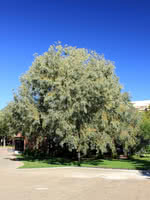Mon-Fri 9am - 5pm Mountain time
Common Hackberry vs Golden Willow
Celtis occidentalis
Salix alba vitellina
The Common Hackberry is a medium-sized deciduous tree that resembles the American Elm but is immune to Dutch Elm Disease. They are versatile and can adapt to a variety of growing conditions.
It produces purple-red, berry-like fruit with a large seed in the center. Both the sweet flesh, which tastes similar to dates, and the crunchy seed are edible. The fruit remains on the tree throughout the winter, offering a valuable food source for birds and other wildlife.
The Common Hackberry can also be a great addition to a pollinator garden. The tree itself is a host for the larvae of several butterfly species and the flowers provide a source of pollen and nectar.
Golden Willow is an attractive accent tree that's perfectly suited for those moist or wet areas on your property.
This fast growing tree has glossy narrow leaves that turn gold in fall, furrowed brown bark and showy gold branches that especially stand out in the winter.
Golden Willow is commonly used for windbreaks, shelterbelts, and ornamental planting. In addition to looking great, Golden Willow attracts a variety of birds and mammals with its twigs and buds.
All willow are important to native pollinators each spring as they have higher amounts of pollen and nectar early each growing season when other food sources are scarce.
Note: do not plant near buildings or buried services.
Common Hackberry Quick Facts
Golden Willow Quick Facts
In row spacing: 2.4 - 3 m (8 - 10 ft)

